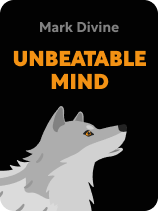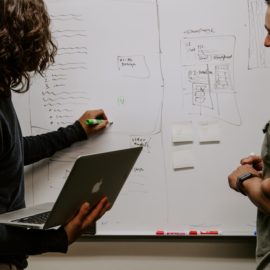

This article is an excerpt from the Shortform book guide to "Unbeatable Mind" by Mark Divine. Shortform has the world's best summaries and analyses of books you should be reading.
Like this article? Sign up for a free trial here.
Want to know how to build self-awareness? Why is understanding the human brain important for developing awareness?
In Unbeatable Mind, Mark Divine writes that developing the mental strength of an unbeatable mind means mastering five levels of personal development. According to him, learning how to build self-awareness is a crucial step in this process.
Read on to learn Divine’s advice for building self-awareness to identify and follow your purpose in life.
Building Self-Awareness
According to Mark Divine’s system in Unbeatable Mind, which features five levels of personal development along with tips for how to traverse these levels, to enact meaningful change within yourself and be able to navigate the five levels of development, you must learn to be constantly aware of what’s going on inside you and around you. This involves understanding how your brain functions and learning how to build self-awareness to best control it.
(Shortform note: You can also use knowledge about how the brain functions to enhance your learning, as research shows that understanding how the brain learns and adopting a growth mindset improves learning outcomes in children.)
Animal Brains
To build self-awareness, you’ll start by learning how to understand your mind, and that includes your physical brain and its different functions. Divine explains that the human brain evolved over millennia, building up from lower levels of functioning and ability to more complex functioning. As it progressed through these stages of evolution, it built upon itself, and many of the neurological traits that formed in our brain’s earliest stages of development have stayed with us rather than being bred out of us.
The three stages of our brain’s evolution are:
1) Reptile: The first of our three “brains” to develop was the reptile brain. It consists of the cerebellum and the brain stem and is responsible for maintaining our basic bodily functions such as heartbeat and motor control.
2) Mammalian: The second brain to develop was the mammalian brain, which is responsible for higher functions like emotions, as well as our reactions to stressors.
3) Monkey: The final brain to develop was the monkey brain, or neocortex. This is responsible for higher-level thinking and learning like analysis, creativity, planning, and decision-making. This brain is ripe with the potential to create and innovate, but it’s also pleasure-seeking and unwilling to tolerate pain. Since pleasure is not always productive and pain is necessary for growth, you must work hard to train this brain.
(Shortform note: The concept of the three animal brains evolving and maintaining their original structure and functions in discrete parts has been widely accepted for decades, but recent research has debunked this idea. It indicates that the human brain did not evolve directly from the reptile brain and that it cannot be separated into distinct regions that function independently of each other. Instead, the brain functions as a highly interconnected web of neural networks that touch on and incorporate all parts of the brain for many different functions.)
According to Divine, these different brains need to be under the control of the mind, which involves learning how to build self-awareness. He emphasizes that the mind is separate from the brain’s neurological functions. He calls the mind the “witness,” meaning the conscious and purposeful awareness of your brain’s functions.
To achieve higher levels of consciousness, you must train your mind to have control over your neocortex. This training can be done through a number of eastern practices like yoga and meditation, and Divine has based his own system on these practices.
(Shortform note: Divine’s view of consciousness as separate from the functioning of the brain is generally not accepted by science. While it may seem like the mind is something greater than the sum of its physical parts, research shows that the processes of the mind and the memories and knowledge that inform those processes are stored physically in the brain, suggesting that the idea of a higher consciousness is an illusion.)
Divine says that in order for the mind to become the master of the neocortex, we have to embrace a state of silence in the mind. To do this, he advises that you push out all distractions, and he recommends various meditation techniques (which we review at the end of the guide).
When you embrace a state of silence, you can better connect with your higher self and the universe. This takes practice and feels unnatural at first, since western culture teaches us to constantly analyze everything. However, tapping into this silence and using it to identify negative thoughts and replace them with positive thoughts is the impetus for personal change.
(Shortform note: In The Art of Happiness, the Dalai Lama recommends a method for stilling the mind that involves taking on a neutral state of mind and pushing out distractions, like Divine’s method. He also emphasizes that you’re not just tuning out, but that you should stay alert and connect with your mind in a pure state.)
How to Use Your Awareness to Fulfill Your Purpose
Divine says that building self-awareness and putting your mind in charge of your neocortex teaches you how to identify and follow your purpose. To identify your purpose, ask yourself how you can pursue your passions, how you can embody the traits you feel are important to your character, and what you exist to do. Once you’ve answered these questions, you can focus on the steps you need to take to fulfill your purpose: building emotional strength, building mental strength, and establishing and following through on goals.

———End of Preview———
Like what you just read? Read the rest of the world's best book summary and analysis of Mark Divine's "Unbeatable Mind" at Shortform.
Here's what you'll find in our full Unbeatable Mind summary:
- Advice from a former Navy SEAL on how to maximize your success
- Tools for training your mind and developing mental toughness
- Why you should come up with a mantra for yourself






